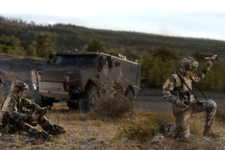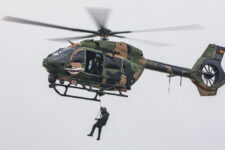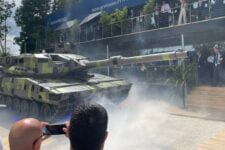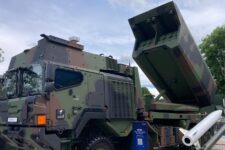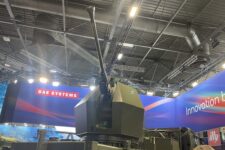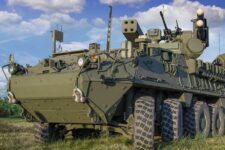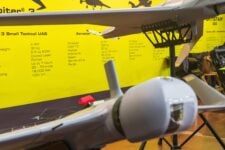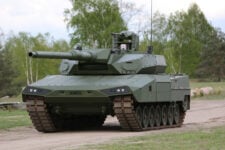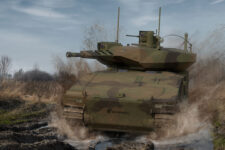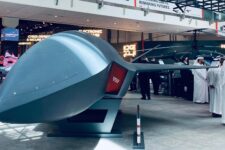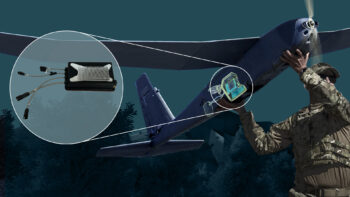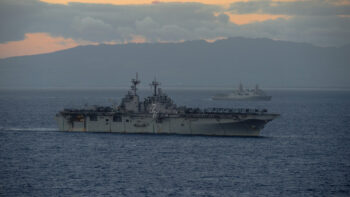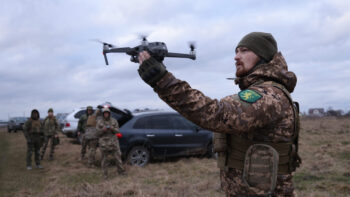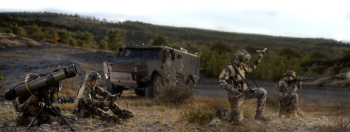
At its core, IBCS is a command and control system for integrated air and missile defense that fuses sensor data for a single, actionable picture of the full battlespace. Photo courtesy of Northrop Grumman.
In this Q&A with Ian Reynolds, vice president, Command, Control, Communication, and Computers (C4) Missile Defense, Combat Systems and Mission Readiness, Northrop Grumman Defense Systems, we discuss: the revolutionary paradigm that IBCS brings to the battlefield, the importance of disaggregating the sensor from the weapon from the C2 system, and how IBCS enables the warfighter to make better informed decisions through a single and integrated air picture of fused sensor data.
Breaking Defense: Let’s frame the threat space and how it’s evolving, and then transition into some of the characteristics of IBCS as it exists today, especially how it’s been demonstrated to stay ahead of those threats.

Ian Reynolds, vice president, C4 Missile Defense, Combat Systems and Mission Readiness, Northrop Grumman Defense Systems.
Reynolds: One of the major challenges for U.S. forces and our Allies across the globe is that the battlespace is becoming increasingly more complex as the threats evolve across multiple domains. This complexity means we must transform decision making so warfighters can quickly deny, disrupt, and defeat threats. And that transformation requires integrating sensors, weapons, and C2 across land, air, sea, space, and cyber. What’s unique and innovative about IBCS is it integrates across the domains. Because it creates a single C2 system, IBCS brings all the sensors and weapons more powerfully to bear in that new threat environment. Beyond integrating across domains, IBCS enables joint operations across services and with our allies and coalition partners.
I like to compare IBCS’ integration of these new systems to how you add an app to your phone. The phone is the base system that powers your delivery of information and ability to act. IBCS serves in a similar manner. It serves as the backbone of responding to a threat. It takes in data from the various systems and delivers actionable decisions for the warfighter. The reason this is so important is that it allows IBCS to remove the data analysis burden so the warfighter can focus on real-time decision making to defeat threats.
For the U.S. Army, IBCS is a transformational capability which will enable the service to replace the current, multiple air and missile defense C2 systems with a single, integrated fire control network. IBCS is the cornerstone of the U.S. Army’s air and missile defense modernization strategy. This isn’t just an important advancement on the battlefield, it also offers a cost saving to the government by reducing total life cycle costs.
IBCS is also fundamental to achieving the DoD’s larger JADC2 vision for joint and coalition network integration. Its architecture is a core foundational element for JADC2 and allows the U.S. and its allies to integrate air and missile defense systems.
Breaking Defense: How would you describe the elements of IBCS and the role they play in the kill chain? What plugs into IBCS?
Reynolds: IBCS’ Integrated Fire Control Network (IFCN) is central to enabling the kill chain for defeating the range of threats operating today across the various domains. The IFCN allows data exchange over various communications networks — radios, satellite, fiber and 4G/5G cellular — and most importantly that data exchange creates fire control quality information. So we’re not just sharing data, we’re creating actionable information that empowers commanders to confidently defeat threats.
The baseline system that recently completed Initial Operational Test and Evaluation (IOTE) encompasses the integration of the Patriot radar and family of missiles, and the Sentinel short range surveillance radar. IBCS will modernize these systems, and by that I mean IBCS will network them to create a broader, more complete view of the battlespace than the current standalone systems provide.
We are also working to integrate the new LTAMDS radar that is still in development. And in the future, we will integrate the Army’s Indirect Fire Protection Capability (IFPC-2) system, which adds a capability for defeating cruise missile threats. Together these currently stovepiped systems will be integrated to provide a single, multi-domain view of the battlespace to provide that fire control quality for warfighters to take action.
In addition, we are investing in the system to ensure IBCS is extensible, meaning it’s ready to integrate new nodes, other C2 systems and international capabilities. We have pursued engineering development, test and demonstration for integrating multi-service sensors and C2.
Integration of Joint Strike Fighter, or F-35, has been successfully demonstrated in two developmental flight tests. This is a critical integration given the importance of that platform for the U.S. and our allies and coalition partners.
We have also successfully demonstrated and tested the integration of the U.S. Marine Corp’s G/ATOR radar via a developing technology called the Joint Track Management Capability (JTMC) bridge. The JTMC enables the fire control network quality data to be exchanged with the U.S. Navy’s Cooperative Engagement Capability (CEC) on which G/ATOR is a participating sensor.
From an international perspective, we have completed proof of concept engineering development and test for integrated Sweden’s GIRAFFE radar and the United Kingdom’s CAMM interceptor. These initiatives were pursued with the manufacturers of both systems, Saab and MBDA respectively. They are also a part of our commitment to working to incorporate sovereign capabilities for our allies.
These are all examples of how IBCS quickly integrates and leverages additional sensors and weapons as they’re developed by U.S. forces and allies. And it shows how we’re able to integrate the capabilities of a particular county into the system to meet their nation’s IAMD requirements, while still remaining interoperable with the U.S.
Breaking Defense: What does IBCS’ MOSA architecture let the system do?
Reynolds: Modular Open System Approach, or MOSA, designed architectures are really powerful and through implementation in the IBCS’ architecture, it enables the capability to componentize existing air and missile defense systems like Patriot, by disaggregating the sensor from the weapon from the C2 system. The open-architecture design allows developers of future sensors and weapons to integrate with IBCS and create a Single Integrated Air Picture to optimally engage hostile threats.
We are agnostic to what the sensor or weapon is. We’re providing a secure, robust, resilient fire control network the warfighter can connect to and take advantage of all the information in the battlespace. I’ll go back to my app analogy, it’s our MOSA architecture that allows IBCS to serve as the brains to integrate all that information.
Breaking Defense: Building on that, it makes sense that LTAMDS and newer systems would be integrated into IBCS because of its agnostic nature as you just mentioned. But how does a legacy system like Patriot connect into IBCS?
Reynolds: The power of IBCS is that it connects systems that were never designed to be integrated. When we do that, it expands our view of the battlespace.
There are multiple ways we can connect IBCS to both legacy air and missile defense systems, as well as new, leading-edge sensors, weapons, and platforms. In addition to directly connecting to IBCS on the fire control network via what we call a “plug and fight” kit, IBCS is capable of communicating through message data protocols like LINK-16 and MADL. We are also working to develop data bridges which enable network and joint service integration like the JTMC bridge for integrating with the Navy’s CEC command and control.
What is particularly powerful about this technology is it enables a high level of network integration without having to make major software changes in the C2 systems and networks that are being integrated. Think back to how I described the similarities to apps on your phone. Your phone isn’t creating those apps, rather they have created the mechanism by which you’re easily able to access data from another company. IBCS uses a similar approach.
Breaking Defense: Once you get the full rate production decision, how are you preparing to ramp up production capability for IBCS? What exactly is being ramped up when you get that decision?
Reynolds: Having recently completed IOTE, the program is on track for a U.S. Army and Department of Defense decision on Full Rate Production later in 2023. We are ready and working with the U.S. Army toward ensuring we are positioned for the decision and have ramped production to meet fielding demand for the U.S. Army and future international acquirers of the system.
Northrop Grumman has tremendous state of the art manufacturing capabilities across our corporation, and we’re bringing all those capabilities to bear to make sure we are prepared for the full-rate production manufacturing decision.
As an example of what we’re doing, one of the key benefits we have at our Huntsville manufacturing center is an active production line that has been producing IBCS hardware for our Foreign Military Sales IBCS case with Poland.
Poland is pursuing an air and missile modernization program that aligns very closely with the U.S. Army in that they are acquiring IBCS to be the single C2 system for both its WISLA Medium Range and NAREW Short Range Air Defense programs. [Editor’s note: In July, Northrop Grumman delivered the first of six production IBCS Engagement Operations Centers (EOC) to the US government under an FMS contract for Poland’s WISLA program for medium-range air and missile defense. It marked the first foreign military sale of IBCS.]
We already have in place the necessary infrastructure, tooling, manufacturing process disciplines and a skilled and experienced labor force to produce both the low rate initial production (LRIP) quantities we’re on contract for now and then to quickly ramp for higher volume.
Breaking Defense: For INDOPACOM’s Valiant Shield, Northrop Grumman systems fused sensor information from multiple services to create a fire-control-quality composite track on a multi-service network, enabling an extended battlespace and allowing better and quicker decisions. Please break that down with some details.
Reynolds: Valiant Shield was an important and powerful exercise, proving that IBCS provides the necessary joint connectivity that the customer’s mission requires.
We demonstrated at Valiant Shield that IBCS was able to network any sensor and weapon across every domain in that real-world exercise. Our system was deployed at Joint Base Lewis-McChord in Washington State where we were a core part of the overall network even far away from the rest of the demonstration. It proved that our adaptable, distributed architecture was still able to utilize the network and all the information coming out of the Pacific to provide the warfighter with a single, integrated air picture connecting multiple service assets despite the large geographical separation.
By having that integrated air picture, the warfighter can focus on executing the best courses of action, confident in their target data. It reduces the amount of data analysis they must do, and instead gives them a game-changing capability to decide and act inside their adversary’s decision loop.
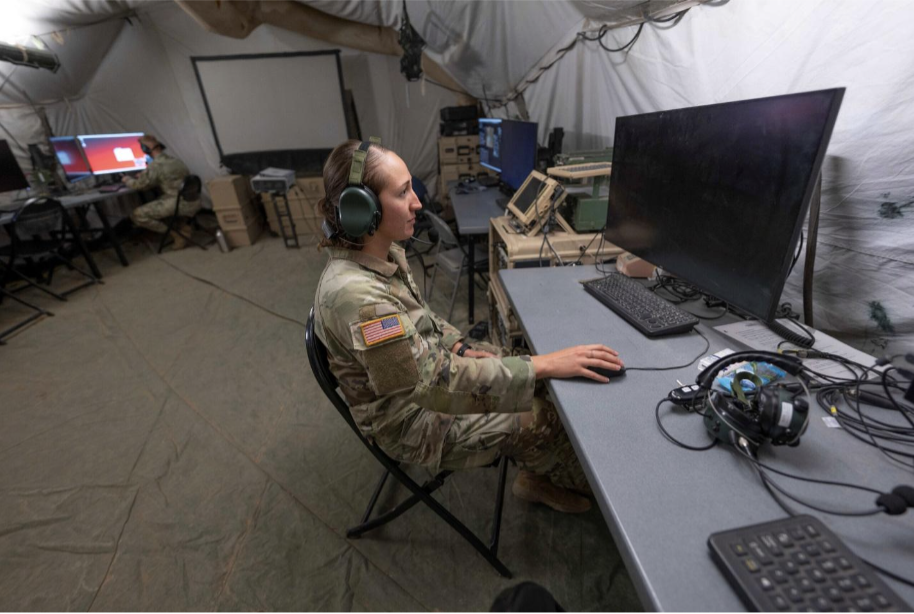
IBCS is the centerpiece of the Army’s modernization strategy for air and missile defense, and will replace all Army air and missile defense C2 systems with the one single IBCS system. Photo courtesy of Northrop Grumman.
Breaking Defense: IBCS has an open, modular and scalable architecture that is foundational to integrating all available assets in the battlespace, regardless of source, service or domain, as you’ve said. In what ways is it “foundational?”
Reynolds: I think of IBCS as foundational in several ways. First, IBCS is the centerpiece of the U.S. Army’s modernization strategy for air and missile defense. It will replace all U.S. Army air and missile defense command and control systems with the one single IBCS system. No longer will each sensor and weapon have a separate C2 system like it exists today. So it’s clearly foundational from that perspective.
The second is the architecture that we’ve been talking about. What’s foundational about it is that it disaggregates air and missile defense systems like Patriot by removing the C2 and placing the sensors and weapons onto an integrated fire-control network. This allows them to be placed where they will be most effective and lets the C2 system take advantage of all the data available from them. What that does is remove complexity from the battlespace, creating one resilient force and one combined picture.
Another foundational element is the MOSA design that allows us to quickly integrate new systems and take advantage of them as they become available. Then there’s the distribution and exchange of fire-control data across the network that improves the lethality of weapons deployed.
Lastly, separating the C2 from the sensors and weapons improves your survivability because you have no single target for the enemy to focus on.
Ultimately the most foundational element of IBCS is its ability to unify all that data into one view of the battlespace, which creates the decision advantage to select the best weapon to take out the threat.

